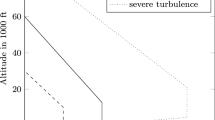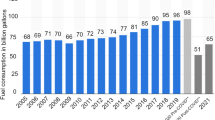Abstract
With the aid of recording systems such as the flight data recorder, information from aircraft sensors can be transmitted in-situ to airlines or maintenance providers during the flight in form of reports, or stored for subsequent analysis in the postprocessing. This allows the determination of current aircraft performance with regard to fuel consumption or emissions. At present, data in a highly aggregated form (predominantly averages) are used for statistical estimations or physical models. The metrics are calculated on a rolling basis as performance indicators of the aircraft and are then compared with book values from the manuals or with data from the performance monitoring system. However, this procedure represents only a situational, aggregated point evaluation of stable flight conditions. The data aggregation is based on strict validity limits for parameter variations. Furthermore, trigger conditions of the recording logic determine the number and quality of the transmitted reports, such, that only a few data points are available for performance analyses. To improve realistic performance analyses, the time series of all aircraft sensors over the entire flight mission (full-flight data) can be used. In contrast to physical models, this study presents data-based approaches using machine-learning tools from the field of artificial intelligence, to develop fuel flow models based on full-flight data. The proposed methods result in detailed statements for the diagnosis of aircraft fuel consumption. The paper deals with the model development and results of different analyses based on a variety of an airline’s operational flight data records. This study describes the learning methods and shows results for two different data-based models, including neural networks and decision trees. Finally, future applications for the models and an outlook on the authors’ activities will be provided.





Similar content being viewed by others
Notes
See: https://www.predix.io/ (Accessed 8 February 2018).
See: https://aerospace.honeywell.com/en/pages/godirect/ (Accessed 8 February 2018).
See: https://services.airbus.com/maintenance/expertise-and-other-services/skywise/skywise/ (Accessed 8 February 2018).
See: https://www.lufthansa-technik.com/aviatar/ (Accessed 8 February 2018).
References
International Air Transport Association (IATA): Fact sheet—fuel. https://www.iata.org/pressroom/facts_figures/fact_sheets/Documents/fact-sheet-fuel.pdf (2017). Accessed 5 Jan 2018
Chati, Y. S., Balakrishnan, H.: Statistical Modeling of Aircraft Engine Fuel Flow Rate. International Council of the Aeronautical Sciences (ICAS). http://www.icas.org/ICAS_ARCHIVE/ICAS2016/data/papers/2016_0619_paper.pdf (2016). Accessed 5 Jan 2018
Horiguchi, Y., Kayahara, H., Maeno, J.: Predicting Fuel Consumption and Flight Delays for Low-Cost Airlines. Association for the Advancement of Artificial Intelligence (AAAI). https://www.aaai.org/ocs/index.php/IAAI/IAAI17/paper/view/14591/13722 (2017). Accessed 5 Jan 2018
Trani, A., Wing-Ho, F., Schilling, G., Baik, H., Seshadri, A.: A Neural network model to estimate aircraft fuel consumption. In: 4th AIAA aviation technology, integration and operations (ATIO) forum, paper 2004-6401. American Institute of Aeronautics and Astronautics (AIAA) (2004)
Turgut, E.T., Rosen, M.A.: Relationship between fuel consumption and altitude for commercial aircraft during descent: preliminary assessment with a genetic algorithm. Aerosp. Sci. Technol. 17(1), 65–73 (2012)
Ertel, W.: Grundkurs Künstliche Intelligenz. Springer, Wiesbaden (2016)
Wickramanayake, S., Bandara, D.: Fuel consumption prediction of fleet vehicles using machine learning: a comparative study. In: 2016 Moratuwa Engineering Research Conference (MERCon), pp. 90–95. Institute of Electrical and Electronics Engineering (IEEE) (2016)
Menon, A.K.: Large-Scale Support Vector Machines: Algorithms and Theory. http://users.cecs.anu.edu.au/~akmenon/papers/research-exam/research-exampaper.pdf (2009). Accessed 8 Jan 2018
Haifeng, Z., Xu-hui, W., Xin-feng, C.: Support vector with ROC optimization method based fuel consumption modeling for civil aircraft. J. Procedia Eng. 99, 296–303 (2015)
Chati, Y., Balakrishnan, H.: A Gaussian process regression approach to model aircraft engine fuel flow rate. In: Proceedings of the 8th ACM/IEEE International Conference on Cyber-Physical Systems (ICCPS2017). Institute of Electrical and Electronics Engineering (IEEE) (2017)
Sturm, M.: Neuronale Netze zur Modellbildung in der Regelungstechnik. Technische Universitaet Muenchen, Institut für Informatik. https://www.mediatum.ub.tum.de/doc/601680/601680.pdf (2000). Accessed 5 Jan 2018
Bol, G., Nakhaeizadeh, G., Vollmer, K.-H.: Datamining und Computational Finance. Springer, Berlin (2000)
Moisen, G.G.: Classification and regression trees. Encycl. Ecol. 1, 582–588 (2008)
Breiman, L., Friedman, J., Stone, C.J., Olshen, R.A.: Classification and Regression Trees. Taylor & Francis Ltd., London (1984)
Alpaydin, E.: Introduction to Machine Learning. MIT Press, Cambridge (2004)
Flach, P.: Machine Learning: the Art and Science of Algorithms that Make Sense of Data. Cambridge University Press, Cambridge (2012)
Breiman, L.: Random Forest. Mach. Learn. 45(1), 5–32 (2001)
Quinlan, J.R.: Learning with continuous classes. In: Adams, D.E., Sterling, E. (eds.) Proceedings AI 1992, pp. 343–348. World Scientific, Singapore (1992)
NASA DASHlink: National Aeronautics and Space Administration (NASA). https://www.c3.nasa.gov/dashlink/ (2017). Accessed 5 Jan 2018
Runkler, T.A.: Data Mining. Springer Vieweg, Wiesbaden (2015)
Baumann, S., Gnisia, M., Feifel, P.: Identifikation und Behandlung von Ausreissern in Flugbetriebsdaten für Machine Learning Modelle. Deutsche Gesellschaft für Luft- und Raumfahrt—Lilienthal-Oberth e.V., urn:nbn:de:101:1-2018122112071383744624 (2018)
McCaffrey, J.: How to standardize data for neural networks. Vis. Studio Mag. https://visualstudiomagazine.com/articles/2014/01/01/how-to-standardizedata-for-neural-networks.aspx (2014). Accessed 8 Jan 2018
Ross, S.M.: Statistik fuer Ingenieure. Elsevier, Muenchen (2006)
Guyon, I., Elisseeff, A.: An introduction to variable and feature selection. J. Mach. Learn. Res. 3, 1157–1182 (2003)
Nunes da Silva, I., Hernane Spatti, D., Andrade Flauzino, R., Bartocci Liboni, L.H., Franco dos Reis Alves, S.: Artificial Neural Networks. Springer, Berlin (2017)
Du, Y., Wu, J., Yang, S., Zhou, L.: Predicting vehicle fuel consumption patterns using floating vehicle data. J. Environ. Sci. 59, 24–29 (2017)
Goodfellow, I., Bengio, Y., Courville, A.: Deep Learning. MIT Press, Cambridge (2016)
Baklacioglu, T.: Modeling the fuel-flow rate of transport aircraft during flight phases using genetic algorithm-optimized neural networks. J. Sci. Technol. 49, 52–62 (2016)
Saxena, A., Celaya, J., Balaban, E., Goebel, K., Saha, B., Saha, S., Schwabacher, M.: Metrics for evaluating performance of prognostic techniques. In: 2008 International Conference on Prognostics and Health Management, pp. 1–17. Institute of Electrical and Electronics Engineering (IEEE) (2008)
Ryerson, M. G., Hansen, M., Hao, L., Seelhorst, M.: Landing on empty: estimating the benefits from reducing fuel uplift in US Civil Aviation. Environmental Res. Lett. 10, 1–11 (2015). http://www.iopscience.iop.org/article/10.1088/1748-9326/10/9/094002/pdf. Accessed 8 Jan 2018
Rebhahn, E.: Energiehandbuch. Springer, Berlin (2002)
Acknowledgements
The authors would like to thank the Federal Ministry of Economics and Energy (BMWi) for their support in the RetroEff project (Retrofit Technology Assessment for Efficient and Economical Aircraft Fleets, sub-funding 20Y1513C) as part of the German Aeronautical Research Programme (LuFo V-2). In this context, large parts of this contribution could be worked out by Technische Universitaet Darmstadt. In addition to the Institute of Flight Systems and Automatic Control at Technische Universitaet Darmstadt, the project RetroEff includes the partners Lufthansa Technik AG and DLR institute Air Transportation Systems. The subproject of Technische Universitaet Darmstadt ends on 31.10.2019.
Author information
Authors and Affiliations
Corresponding author
Additional information
Publisher's Note
Springer Nature remains neutral with regard to jurisdictional claims in published maps and institutional affiliations.
Rights and permissions
About this article
Cite this article
Baumann, S., Klingauf, U. Modeling of aircraft fuel consumption using machine learning algorithms. CEAS Aeronaut J 11, 277–287 (2020). https://doi.org/10.1007/s13272-019-00422-0
Received:
Revised:
Accepted:
Published:
Issue Date:
DOI: https://doi.org/10.1007/s13272-019-00422-0




